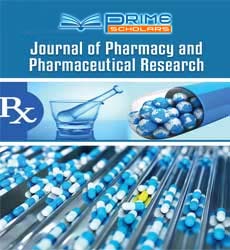Commentary Article - (2022) Volume 6, Issue 2
Biopharmaceutics and Its Classification
Kelvin Agarwal*
Department of Biopharmaceutical, University of Guelma, Algeria
*Correspondence:
Kelvin Agarwal, Department of Biopharmaceutical, University of Guelma,
Algeria,
Email:
Received: 29-Mar-2022, Manuscript No. IPIPR- 22-13396;
Editor assigned: 31-Mar-2022, Pre QC No. IPIPR- 22-13396(QC);
Reviewed: 14-Apr-2022, QC No. IPIPR- 22-13396;
Revised: 19-Apr-2022, Manuscript No. IPIPR- 22-13396(R);
Published:
26-Apr-2022, DOI: 10.21767/ipipr.6.2.07
Description
Drugs are chemical substances that, when ingested, alter the biological
and psychological functions of living organisms. Drugs
are often classified as food and nutritional supplements. Drugs
can be inhaled, injected, smoked and absorbed, absorbed by
skin spots, suppositories, or dissolved under the tongue. In
pharmacology, drugs are chemicals, often known properties
that have biological effects when given to the body. Drugs, also
known as drugs or drugs, are chemicals used to treat, cure, prevent,
diagnose, or promote well-being. Traditionally, medicines
are obtained by taking them from medicinal plants, but more
recently through organic synthesis. Medicines can be used for
a limited time or for chronic illnesses. Drugs are often classified
as drugs. A group of related drugs with similar chemical properties,
a similar mechanism of action (binding to a biological
target), and related mechanisms associated with the treatment
of the same disease. The Anatomical Therapeutic Chemistry
Classification System “ATC” is a widely used drug classification
system and has a unique ATC code which is a code of letters
and numbers that allows a specific class of drugs within the
ATC assigned to the system. Assign a tree. Another important
system for classifying biopharmaceutics classification system.
It classifies drugs according to their solubility and permeability
or absorption properties. Psychotropic drugs are chemicals
that affect the functioning of the central nervous system and
alter perception, emotion, or consciousness. These drugs are
divided into different groups such as stimulants, antiretrovirals,
antidepressants, anxiolytics, antipsychotics, and hallucinogens.
These psychotropic drugs have been shown to be effective in
treating a variety of medical conditions, including mental disorders
worldwide. The most commonly used drugs in the world
include caffeine, nicotine, and alcohol. They are also considered
recreational drugs because they are used for hedonic purposes
rather than therapeutic purposes. All medications have
side effects. Misuse of many psychotropic drugs can lead to addiction and physical addiction. Excessive stimulus can stimulate
the mind to stimulate. Many recreational drugs are illegal and
have international conventions, such as the Single Convention
on Narcotic Drugs prohibiting them. Medications and medications
are oral medications to treat or reduce symptoms of illness
or health condition. It can also be used as a prophylactic
and will work in the future, but it cannot cure existing or existing
diseases or symptoms. Drug production is usually regulated
by the government in three phases.
Conclusion
Prices are available at pharmacies and supermarkets without
any restrictions. Prescription drugs are dispensed by a pharmacist
without the need for a prescription, as well as prescription
drugs that should be given by a qualified medical professional,
usually a physician. Unlicensed drugs are known as pharmaceutical
drugs and may only be sold or under the direction of
a pharmacist under a registered pharmacy. These drugs are
marked with the letter P on the label. Drugs, also known as
drugs or drugs, are chemicals used to treat, cure, prevent, diagnose,
or promote well-being. Traditionally, medicines are obtained
by taking them from medicinal plants, but more recently
through organic synthesis. Medicines can be used for a limited
time or for chronic illnesses.
Acknowledgement
The author is grateful to the journal editor and the anonymous
reviewers for their helpful comments and suggestions.
Conflict of Interest
The author declared no potential conflicts of interest for the
research, authorship, and/or publication of this article.
Citation: Kelvin A (2022) Biopharmaceutics and Its Classification. J Pharm Pharm Res Vol.6 No.2:07
Copyright: © Kelvin A. This is an open-access article distributed under the terms of the Creative Commons Attribution License,
which permits unrestricted use, distribution, and reproduction in any medium, provided the original author and source are
credited

